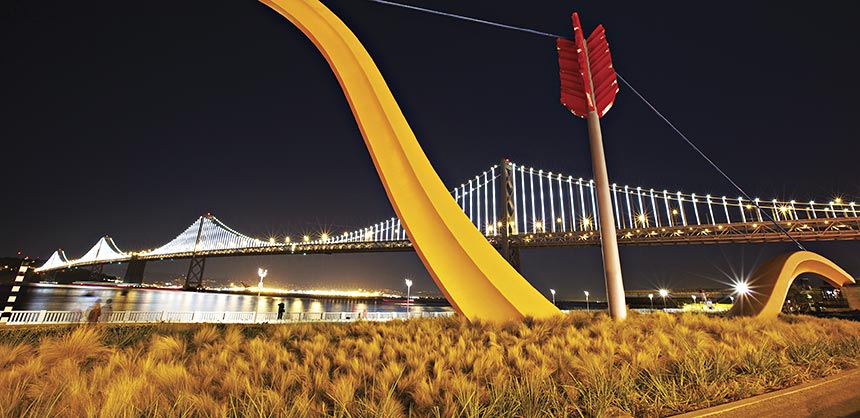Destination MarketingFebruary 1, 2014
The Future Is Now By Derek ReveronDestination Marketing
The Future Is Now
Could this massive sculpture called Cupid’s Span be one of the iconic images to appear on San Francisco’s new game app? Credit: San Francisco Travel
Destination Marketing Organizations (DMOs), also known as Convention & Visitors Bureaus (CVBs), are hopping on the digital and social media marketing bandwagon to promote their destinations to planners and the public, vie with competitors for meetings, and grow return on investment.
Indeed, DMO websites are centerpieces of marketing efforts. The sites are integrated with social media sites such as Facebook, Twitter and Pinterest to provide resources and information that meeting planners need to sell destinations to groups and executives.
Looking to leverage the power of social media, DMOs are forging social media partnerships with hotels, restaurants, attractions and others to co-promote destinations. Many DMOs are stepping up marketing via smartphones and tablets and optimizing their websites to make browsing easier on the small screens of mobile devices.
Websites Provide a Wealth of Information
DMO websites are often the first stop for 25-year meeting planning veteran Maureen Santoro, manager of group operations at Atlas Meetings + Incentives in Milford, MA. “When I first started as a planner with no experience, CVB sites were a great help to learn about destinations,” says Santoro. “But as I grew as a planner and became more experienced and well-traveled, I used them less. But now I’m back to using the websites again, very much so due to the information they offer. They are a lot more sophisticated and designed like a planner thinks.”
Santoro knows what she wants on DMO sites. “I look for downloadable versions of information such as meeting and convention services booklets, links to suppliers and a planner’s toolbox,” says Santoro. “There are also checklists and templates to help with planning. I also check meeting schedules to see if there is a large city-wide happening to tell me if pricing is going to be an issue because availability will be tight.”
Recently, Santoro navigated the Visit Tucson site as she began planning a four-day meeting for 60 executives of an industrial machinery company. She examined several sources. “I spent a good amount of time on the site,” says Santoro. “I looked at everything — hotels, resorts, things to do, the weather, transportation, the Tucson region and volunteerism opportunities, which are important to the clients. When I was done absorbing what I could on the site, I got the name of a CVB person from the site and called that person. She gave me valuable information about hotels to consider that I couldn’t get on the website.”
Santoro finds that DMO digital information helps her zero in on attributes of a destination to educate and persuade groups and C-suite executives. “If I’m trying to convince a group to go to a destination and I don’t know much about it, then I’m not going to sound convincing,” says Santoro. “The information I get from a website in combination with speaking to somebody is invaluable in taking the information and passing it along to clients. If they are on the fence about a location, it might actually help make up their mind.”
Traditional and Digital Marketing Activities
Planners are finding that social and digital media play an increasingly large role in DMO marketing. The Destination Marketing Association International’s 2012 DMO Marketing Activities Study sums up the progress: “Although traditional marketing (print/broadcast advertising, consumer shows/events) still commands a large share of DMO leisure marketing dollars, there is a noticeable commitment toward digital marketing,” the report states.
“DMOs have fully embraced a wide variety of online activities into their overall destination marketing efforts. Banner ads and search engine marketing (SEM)/adwords dominate, comprising more than half of DMO online budgets. Social media is now a permanent element of destination marketing, with almost all responding DMOs present on Facebook, Twitter and YouTube,” states the report.
Numbers tell the story. Traditional marketing methods account for 63 percent of the total of all DMO marketing budgets, while digital efforts make up 34 percent, the study reports. Ninety-eight percent of DMOs use Facebook, 91 percent are on Twitter and 88 percent utilize YouTube.
Much of the information that DMOs market to planners also is available on digital sources other than CVB websites. For example, planners such as Mary Ann Willingham, who extensively use services such as Cvent also use CVB marketing information. Willingham, director, meetings IQ operations and account management for Plymouth, MN-based Travel Leaders Group LLC, says that they also use CVB sites because they don’t want to rely on a single source for information that’s important to their clients. “We use CVB sites as much as anything to make sure we haven’t overlooked any information. And the information from Cvent can be a starting point to contact CVBs for more specifics and establish a relationship if none exists.”
Willingham cites an example of how she uses CVB digital information. “We have one customer that goes to Australia every year. Very often, they want to do something different, like a different restaurant or activity. So the CVB information in a place like Sydney can be very useful. Information that we get on a community, whether we get it from a CVB or Cvent, is crucial to a presentation, because the more information you have about a destination, the better,” says Willingham.








